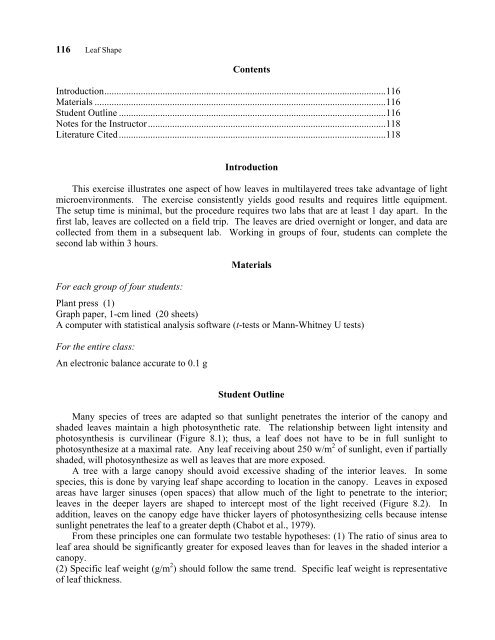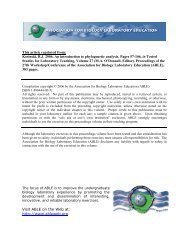Developmental Plasticity in Oak Leaves David Westmoreland
Developmental Plasticity in Oak Leaves David Westmoreland
Developmental Plasticity in Oak Leaves David Westmoreland
Create successful ePaper yourself
Turn your PDF publications into a flip-book with our unique Google optimized e-Paper software.
116 Leaf Shape<br />
Contents<br />
Introduction....................................................................................................................116<br />
Materials ........................................................................................................................116<br />
Student Outl<strong>in</strong>e ..............................................................................................................116<br />
Notes for the Instructor..................................................................................................118<br />
Literature Cited..............................................................................................................118<br />
Introduction<br />
This exercise illustrates one aspect of how leaves <strong>in</strong> multilayered trees take advantage of light<br />
microenvironments. The exercise consistently yields good results and requires little equipment.<br />
The setup time is m<strong>in</strong>imal, but the procedure requires two labs that are at least 1 day apart. In the<br />
first lab, leaves are collected on a field trip. The leaves are dried overnight or longer, and data are<br />
collected from them <strong>in</strong> a subsequent lab. Work<strong>in</strong>g <strong>in</strong> groups of four, students can complete the<br />
second lab with<strong>in</strong> 3 hours.<br />
Materials<br />
For each group of four students:<br />
Plant press (1)<br />
Graph paper, 1-cm l<strong>in</strong>ed (20 sheets)<br />
A computer with statistical analysis software (t-tests or Mann-Whitney U tests)<br />
For the entire class:<br />
An electronic balance accurate to 0.1 g<br />
Student Outl<strong>in</strong>e<br />
Many species of trees are adapted so that sunlight penetrates the <strong>in</strong>terior of the canopy and<br />
shaded leaves ma<strong>in</strong>ta<strong>in</strong> a high photosynthetic rate. The relationship between light <strong>in</strong>tensity and<br />
photosynthesis is curvil<strong>in</strong>ear (Figure 8.1); thus, a leaf does not have to be <strong>in</strong> full sunlight to<br />
photosynthesize at a maximal rate. Any leaf receiv<strong>in</strong>g about 250 w/m 2 of sunlight, even if partially<br />
shaded, will photosynthesize as well as leaves that are more exposed.<br />
A tree with a large canopy should avoid excessive shad<strong>in</strong>g of the <strong>in</strong>terior leaves. In some<br />
species, this is done by vary<strong>in</strong>g leaf shape accord<strong>in</strong>g to location <strong>in</strong> the canopy. <strong>Leaves</strong> <strong>in</strong> exposed<br />
areas have larger s<strong>in</strong>uses (open spaces) that allow much of the light to penetrate to the <strong>in</strong>terior;<br />
leaves <strong>in</strong> the deeper layers are shaped to <strong>in</strong>tercept most of the light received (Figure 8.2). In<br />
addition, leaves on the canopy edge have thicker layers of photosynthesiz<strong>in</strong>g cells because <strong>in</strong>tense<br />
sunlight penetrates the leaf to a greater depth (Chabot et al., 1979).<br />
From these pr<strong>in</strong>ciples one can formulate two testable hypotheses: (1) The ratio of s<strong>in</strong>us area to<br />
leaf area should be significantly greater for exposed leaves than for leaves <strong>in</strong> the shaded <strong>in</strong>terior a<br />
canopy.<br />
(2) Specific leaf weight (g/m 2 ) should follow the same trend. Specific leaf weight is representative<br />
of leaf thickness.
















